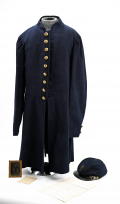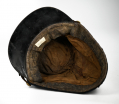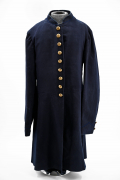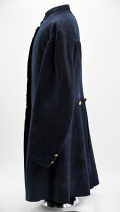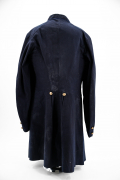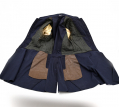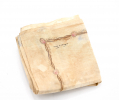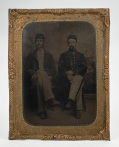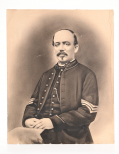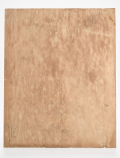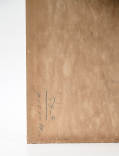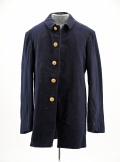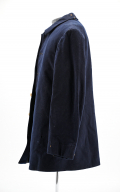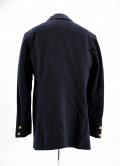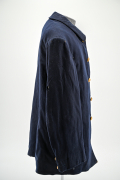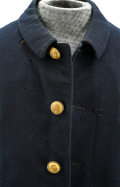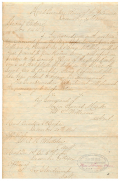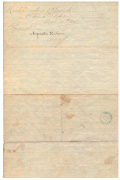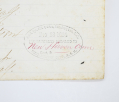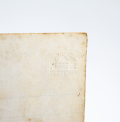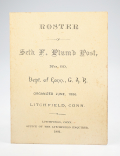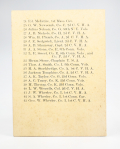site search
online catalog
FORAGE CAP, FROCK COAT, AND HANDKERCHIEF OF SETH F. PLUMB 8th CT, KIA CHAFFIN’S BLUFF (FORT HARRISON)
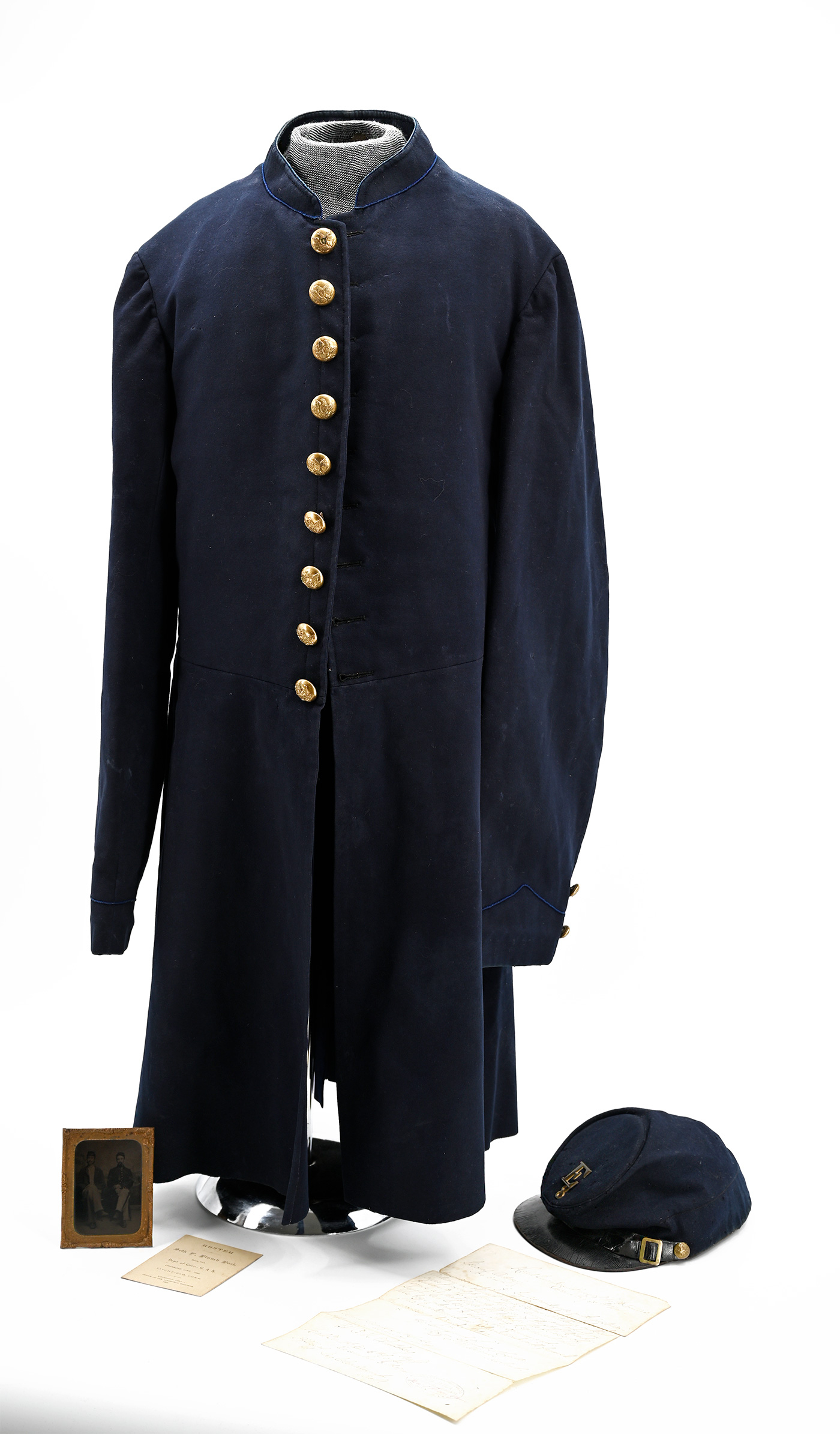
$18,000.00 SOLD
Quantity Available: None
Item Code: 1179-159
This uniform grouping was worn by a soldier who enlisted in the 8th Connecticut at its organization, was present in almost all its engagements, and was killed in its last combat action of the war, at Fort Harrison on September 29, 1864. The group was formerly on display in the Texas Civil War Museum and has a tight provenance going back to its sale at auction by the family. Included in the paperwork are letters from the auctioneer who sold it, the dealer who bought it, and correspondence between a later collector who owned it and the family who originally consigned it. Also included are an assessment and a treatment report by a textile conservator who stabilized the fatigue cap in the grouping as well as a copy of the 1989 article about the soldier published in Military Images.
The core of the group is Seth Plumb’s forage cap with original brass, frock coat, and personally marked handkerchief, along with a charcoal solar enlargement of him as a sergeant. Plumb’s NCO sash and a shirt also came out with this material from the family and we will make every effort to make them available to the buyer, but offer the group as it now stands. Included with Seth Plumb’s items are also his brother’s G.A.R. coat and wartime orders posting his brother, a private in the 2nd Connecticut Heavy Artillery, to a recruiting rendezvous in late 1864, a roster the Litchfield, CT., G.A.R. post named in Seth Plumb’s honor, and a ¼ plate tintype of two soldiers, possibly Seth Plumb, his brother, or friends.
CAP: Type-II with narrow top, crescent visor. Original brass E and 8 on top lower front. Chinstrap with floating friction buckle and two stop loops. Small general service eagle side buttons in place. The condition is very good. A textile conservator’s report is included indicating the aside from light cleaning very little was done to the cap other than underlying areas of pinhole moth damage with a navy blue wool fabric and stitching it in place with a navy polyester filament thread. This stabilized the fabric and concealed the moth nips that mostly small and on the front: 4+ on the crown, about the same number on the sides and back, and more (20+) but still very small ones on the front. These are only visible on close inspection.
The interior lining and sweatband are complete. Sweatband shows stains, but is solid, and at center front has a small piece of adhesive tape with the name “Plumb” on it. The underside of the crown shows the brass is attached with two small wood pegs. Nice color. Obvious wear, but no substantial damage. Moth nips blend in and are not obvious. See conservation report.
COAT: This is a regulation pattern infantry enlisted coat, but with a nicer quality, officer’s style, lining and Infantry-I buttons, indicating Plumb privately purchased it, most likely for wear as a First Sergeant but did not procure chevrons. He had been promoted and mustered in as First Sergeant on Jan. 5, 1864, while in Connecticut on recruiting duty from November 24, 1863, to February or March 1864, and he may have left it behind when returning to the front then, or after the expiration of a thirty day veteran’s leave granted him on July 30. This latter period is perhaps the most likely. Plumb was commissioned a lieutenant to date July 17, 1864. He was never mustered in at that rank, but if he was expecting it he may have left the coat and his sergeant’s sash behind at that point: the family preserved both and his captain listed “no effects” in the inventory made in the field after his death.
The coat is dark blue with standing collar and cuffs trimmed with a narrow light or medium blue cord. The buttons have “Extra Quality” back marks and are all in place: nine on the front, two on each non-functional cuff and two on the rear waist. The coat is lined in the chest, sides, and sleeves like a standard issue coat, but the lining is a nicer quilted greenish silk as found in officer’s coats. There is a single pocket in the left breast and two polished cotton pockets in the unlined skirts, accessible from the inside. The coat is solid, has great color, just a very few pencil point moth nips: three on the left rear collar, another on the lower left back and two on the lower left skirt. The seams are tight. We see only one short opening on the lower left back just above the left waist button. There are some thin stains, however, on the lower left center of the back, lower left skirt, back of the lower left and right sleeves, some on the lower left front skirt and right hip. These have not affected the integrity of the fabric and show up only as slightly lighter areas that are not readily discernible in most lighting. The coat has a small rectangular glue stain in the collar that probably marks the place of an old label reading “Plumb,” just as is still present in the cap.
The identification of the group was made doubly certain by the presence of colored handkerchief stamped “Seth F. Plumb” along with a letter from the auctioneer stating that the handkerchief was discovered in a pocket of the coat at the auction.
HANDKERCHIEF: 22.5 by 23 inches. Solid, no holes, stains overall, narrow printed border showing a twisted ribbon with flowers and vine. Soft reds and browns (perhaps oxidized black.) Small ink stamp inside one corner “Seth F. Plumb.”
IMAGES. Two images are present in the group. One is a quarterplate tintype of a seated private and sergeant in front of a painted backdrop with a period note on the back: “Taken at Neberne (sic) / North Carolina / 1863.” The private, seated on the left, bears a resemblance to Plumb, but both men may be friends from the unit. The MI article cites a letter from Plumb with news that a best friend had been killed at Drewry’s Bluff in May 1864. A second image is a charcoal portrait or “solar enlargement” of Plumb himself, seated in a half-length view wearing a sergeant’s frock coat. This is identical to an identified view of him published in a county history that is either a vignetted version or taken at the same sitting. The portrait is in very good condition, unframed, 16 by 20 inches, and was illustrated in the MI article.
GAR COAT AND WARTIME SPECIAL ORDERS OF SETH PLUMB’S BROTHER
William H. Plumb (1840-1916) served as a private in 19th Connecticut Infantry/ 2nd CT Heavy Artillery, 8/9/62 to 6/14/65. The coat is a typical G.A.R. sack coat with roll-over collar, five GAR buttons on the front and two small ones on each cuff. Boston “Oak Hall Clothing Company,” embroidered hanging tab inside the collar dating 1896-1913. Fully lined in the body and sleeves. One interior pocket in the wearer’s left breast. Coat is solid and has good color, but with scattered small moth nips overall and some larger holes, ½ inch or so, on the left rear collar, upper right rear sleeve, and left armpit. No conservation or repairs. Still displays well. With this is a December 20, 1864, dated copy of Special Orders No 344 from Head Quarters Army of the Potomac, ordering William H. Plumb, Co. A 2nd Conn. Artillery to report for duty at a draft rendezvous in New Haven with transportation to be provided and is stamped by the Asst. Qr. Master’s Office in Washington indicating transportation was so provided. The letter is fully legible and in good condition, but with the upper quarter separated along a separation line across a horizontal fold.
OTHER MATERIAL
With the group is an 1891 printed roster of members of the Seth F. Plumb Post #80 Dept. of Connecticut G.A.R.
Seth Plumb enlisted at age 25 on 9/6/61 and mustered into Co. E of the 8th Connecticut as a sergeant on 9/25/61. His entry in the Company Descriptive Book says he was, “in action at Roanoke Island, Newbern, Antietam, Fredericksburg & the siege of Suffolk, Walthall Junction, Near fort Darling, Cold Harbor, Petersburg, & killed at fort Harrison.” This comprises pretty much all of the regiment’s battle honors, which are credited as: Newbern, N. C., March 14, 1862; Siege of Fort Macon, N. C., April, 1862; Antietam, Md., Sep. 17, 1862; Fredericksburg, Va., Dec. 13, 1863; Fort Huger, Va., April 19, 1863; Walthall Junction, Va., May 7, 1864; Fort Darling, Va., May 16, 1864; Petersburg, Va., August 25, 1864; Fort Harrison, Va., Sep. 29, 1864.
The regiment left Hartford October 17, 1861, trained briefly at a camp of instruction on Long Island, and on November 1 proceeded to Annapolis. It sailed with Burnside’s Coastal Expedition, was present in reserve during the Battle of Roanoke, and took part in the attack on New Bern in March, losing 2 killed and 4 wounded. In April Plumb was at siege of Fort Macon, which was reduced by Union artillery, but reportedly only raised the white flag as a charge led by Plumb and another sergeant placed Union troop atop the parapets. In September, the regiment was heavily engaged at Antietam, losing 194 killed, wounded, or missing, Plumb writing home that he had fired “12 or 14 rounds at close range.” At Fredericksburg they were lightly engaged, but in Spring 1863 they moved back to Suffolk where Plumb took part in the capture of a fort on the Nansemond River. Clambering off a boat that had maneuvered close to shore, Plum and others waded to dry ground and then storming the fort under fire, capturing five guns and the garrison of 125, who narrowly escaped massacre when an artillery piece was fired on the Union troops after a flag of surrender had been raised.
Plumb reenlisted as veteran in late 1863 and was promoted to first sergeant, mustering in at that rank on January 5, 1864, while in Connecticut on recruiting duty. This lasted until about March 1864, when he was back at the front serving with the pioneer corps, with the regiment seeing action at Walthall Junction, Drewry’s Bluff, Cold Harbor, and Petersburg. His detail on recruiting duty did not count against his veteran’s leave, which he took starting in late July. Back with the regiment by late August, allowing for a 30-day leave, he was with the regiment when it crossed the James River to take part in the attack on Confederate lines at New Market Heights and Chaffin’s Bluff. Plumb was killed in the attack that took Fort Harrison, renamed Fort Burnham in honor of the 8th Connecticut’s brigade commander, also killed in the fighting. Plumb was one of the regiment’s eight killed and sixty-five wounded in the battle, their last combat action of the war. [sr] [ph:L]
~~~~~~~~~~~~~~~~~~~~~~~~~~~~~~~~~~~
THIS ITEM, AS WITH ALL OTHER ITEMS AVAILABLE ON OUR WEB SITE,
MAY BE PURCHASED THROUGH OUR LAYAWAY PROGRAM.
CLICK HERE FOR OUR POLICIES AND TERMS.
THANK YOU!
Inquire About FORAGE CAP, FROCK COAT, AND HANDKERCHIEF OF SETH F. PLUMB 8th CT, KIA CHAFFIN’S BLUFF (FORT HARRISON)
For inquiries, please email us at [email protected]
Most Popular
Historical Firearms Stolen From The National Civil War Museum In Harrisburg, Pa »
Theft From Gravesite Of Gen. John Reynolds »
Selection Of Unframed Prints By Don Troiani »
Fine Condition Brass Infantry Bugle Insignia »
British Imported, Confederate Used Bayonet »
Scarce New Model 1865 Sharps Still In Percussion Near Factory New »
featured item
EXCELLENT PAIR OF US BOOTEES/BROGANS
This original pair of standard issue Jefferson Booties, often called “Brogans”, come to us in a virtually pristine condition relative to their age and materials of composition. Showing no signs of outright damage, they do feature some very minor… (490-7151). Learn More »



